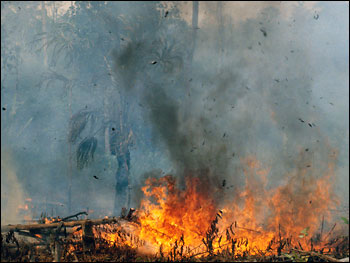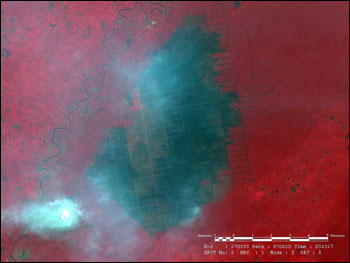

Restocking the Nutrient Shelves at the Surface of the Ocean | |||
Most ocean life goes about its business in the surface waters of the world’s oceans, where sunlight feeds plants, and plants feed animals. Over eons, the remains of millions of creatures that lived and died at the ocean surface sink to the ocean floor and decay, filling the bottom waters with nutrients. When this deep water bubbles up to the surface, it’s like a shot of vitamins for surface-dwelling ocean life. Spiked with nutrients, the water explodes with a great bloom of marine plants called phytoplankton. Phytoplankton blooms, though, aren’t really a rare occurrence in the region. In many cases, such blooms are a benefit and even a necessity to maintaining a healthy ecosystem; these tiny plants are the foundation of the food chain. Although most nutrients that the ocean plants need to grow are widely available in coastal upwelling zones such as the waters around the Mentawai Islands, there is another necessary nutrient that is more difficult for phytoplankton to come by: iron. The major source of iron in the ocean is dust that blows off the land surface and settles on the ocean. In general, this transport of iron doesn’t keep pace with the availability of the other nutrients driven to the surface by the upwelling, and so plant growth is limited by the availability of iron. |
|||

Phytoplankton populations can skyrocket when the ocean receives a sudden influx of iron-rich dust; Saharan dust storms blowing across the Atlantic Ocean have long been known to cause devastating red tides in the Gulf of Mexico. The massive red tide that destroyed the reefs off Sumatra seemed suspiciously similar, but unfortunately, there were no scientific studies of the event that Abram could turn to. Instead Abram used satellite data from the Sea-viewing Wide Field-of-view Sensor (SeaWIFS) to verify local reports of an atypical red tide. “We used SeaWiFS data to examine the productivity in the ocean around the Mentawai Islands at the time of the reef death. The chlorophyll-a concentrations detected by SeaWiFS in December 1997 show a region of elevated productivity around the Mentawai Island chain that is consistent with local observations of the red tide,” says Abram. A high concentration of chlorophyll in the water means a lot of plant life is present. The local reports and the SeaWiFS imagery confirmed that there was indeed a unusual red tide around the Mentawai Islands in late 1997, which left only one question: what caused it? If the dipole had been occurring for 7,000 years without killing off the reefs, then clearly some other event must have coincided with the upwelling that had never occurred in at least 7,000 years. Since the Mentawai Island region of the Indian Ocean is an iron-limited region, it wasn’t too much of a leap to assume that some sort of massive iron fertilization had occurred. Abram didn’t have to hunt very long to identify a potential culprit: a staggering and probably unprecedented number of forest fires burning just to the east in the jungles of Sumatra and East Kalimantan, Borneo. |
According to locals, the Mentawai reefs died in 1997 “when the sea turned red,” the result of a bloom of microscopic plants including red algae. In December of that year, the Sea-viewing Wide Field-of-view Sensor recorded chlorophyll concentrations (which are proportional to the density of plant populations) that ranged from 1 milligram per cubic meter of water (green) to nearly 60 milligrams (red). In 2000, a more typical year, the chlorophyll concentration around the reefs didn’t exceed 1 milligram. The amount of iron needed to support such a large red tide would have been between 10 and 50 times what local sources could have provided. (Images courtesy SeaWiFS Project.) | ||

Forest Fires Add the Missing IngredientDifferent parts of the world feel the effects of the El Niño-Southern Oscillation ocean cycle more or less strongly. Indonesia is one of the places strongly influenced by it; El Niño produces drought across most of the region. In late 1997, the drought was hammering the whole of Indonesia, with rainfall deficits of 400-500 millimeters in many places. In the midst of this exceptional drought, the growing use of fire as a forest and agricultural management tool in the region became disastrous. In the absence of sufficient caution, forest fires exploded across the dry landscape. |
Uncontrolled forest fires sprang up all over Indonesia in late 1997 and early 1998, especially on the islands of Sumatra and Borneo. This smoky fire occured in Borneo’s East Kalimantan province. (Photograph copyright Global Fire Monitoring Center) | ||

A study by German scientists revealed that recently logged forests were most severely affected. In the near-14-million-hectare study area (almost all of East Taklimakan), 73 percent of peat swamp forests, 75.5 percent of secondary forest, plantation, or farmland, and 81 percent of wetlands burned during the 1997-98 El Niño season fires. Those that didn’t burn completely left behind fuel for the next round of devastating fires. The scale of the disaster was unprecedented. And the impact of fires isn’t just on the land; it’s also in the air. “When fires burn,” explains Abram, “nutrients from the plants and soil go into the atmosphere in smoke, and as this smoke settles, the nutrients fertilize surrounding environments.” Ash fallout from the staggering number of fires burning in the tropical forests of Sumatra could have added the final fatal ingredient needed to push algae populations—already primed with the nutrients from the Indian Ocean Dipole upwelling—to deadly levels. Abram tracked the spread of the smoke with satellite observations from NASA’s Total Ozone Mapping Spectrometer—TOMS for short. TOMS measures more than just ozone, including smoke and other air pollution. |
This image shows a plantation near Jambi, Sumatra, being cleared out of the forest using fire. The SPOT 2 satellite captured the image on August 20, 1997. It is made from a combination of visible and infrared light. Vegetation appears bright red, while the burned area appears charcoal gray. Many of the wildfires that plagued Indonesia in late 1997 were ignited intentionally to clear land for agriculture, but got out of control due to the unusually dry conditions. (Image courtesy Centre for Remote Imaging, Sensing and Processing copyright CNES) | ||

TOMS observations revealed that with the Indian Ocean Dipole event driving winds from the east, as much as 46 percent of the smoke from the Sumatran wildfires may have spread across the Mentawai reef area. The cool ocean waters caused by the Indian Ocean Dipole upwelling had chilled the air, and cold air tends not to rise, keeping the smoke over the reefs. Abram thinks the smoke is the most likely culprit for fertilizing the algae bloom that suffocated or poisoned nearly every living coral for hundreds of square kilometers. |
NASA’s satellite-based Total Ozone Mapping Spectrometer tracked the smoke from Indonesian wildfires as it spread westward and blanketed the Mentawai Islands. Aerosol index indicates smoke thickness. The minimum value of 1.0 represents smoke that is roughly as thick as a smoggy day in Los Angeles. Gray, yellow, and red areas are covered by progressively thicker smoke. As iron-rich ash settled on the ocean, it unleashed a massive red tide that killed off the Mentawai coral reefs. (Image courtesy TOMS Science Team) | ||